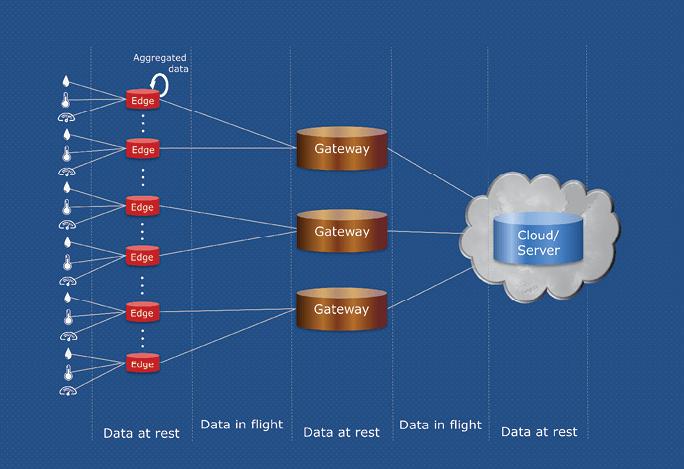Introductiontoembeddeddatabase
Inembeddedsystems,theoperationofthedatabasehasthecharacteristicsoftimelimit.Here,thedatabasesystemappliedtotheembeddedsystemiscalledtheembeddeddatabasesystemorEmbeddedreal-timedatabasesystem(ERTDBS).
Thereliabilityrequirementsareunquestionable.Theembeddedsystemmustbeabletorununinterruptedlyforalongtimewithoutmanualintervention.Atthesametime,databaseoperationsarerequiredtobepredictable,andthesizeandperformanceofthesystemmustalsobepredictable,soastoensuretheperformanceofthesystem.Embeddedsystemswillinevitablydealwiththeunderlyinghardware,soindatamanagement,theremustalsobetheabilitytocontroltheunderlying,suchaswhendiskoperationswilloccur,thenumberofdiskoperations,howtocontrol,etc.Theabilityoflow-levelcontrolisthekeytodeterminingdatabasemanagementoperations.
Oneofthecurrentchallengesinthedevelopmentofembeddedsoftwaresystemsisembodiedinwhetherasetofreliable,efficientandstablemanagementmodelscanbeestablishedforthemanagementofvariousdata.Embeddeddatabasescanbesaidtohaveemergedasthetimesrequire.
Embeddeddatabaseisanimportantpartofembeddedsystem,andithasalsobecomeanindispensableeffectivemeansformoreandmorepersonalizedapplicationdevelopmentandmanagement.
Embeddeddatabaseshaveawiderangeofuses,suchasconsumerelectronics,mobilecomputingdevices,enterprisereal-timemanagementapplications,networkstorageandmanagement,andvariousspecialequipment.Thismarketiscurrentlyundergoingrapidgrowth.Togiveasimpleexample,mobilephoneswereoriginallyonlyusedformakingcallsandsendingtextmessages.Nowmobilephoneshaveaddedmanynewfunctions,suchasMMS,music,photography,video,etc.,withmoreapplicationfunctions,thesystembecomesmorecomplicated.
Comparisonofcommonlyusedembeddeddatabases
Progress
ProgresssoftwarecompanyannouncedinBeijingat18:00onApril18,2000,thefullreleaseontheLinuxoperatingsystemTherunningdatabaseanditsdeploymentproducts.Progresshastheworld'snumberonemarketshareintheembeddeddatabasemarket.Morethan2millionpeopleintheworldareusingProgressSoftware'sapplicationsoftware.Currently,thenumberofsitesdeployingProgressproductshasexceeded100,000.ThroughProgressSoftware'sfirstLinuxversionoftheembeddeddatabase,independentsoftwaredevelopersandenduserscanportmorethan5,000commercialapplicationsonthispopularoperatingsystem.
----TheproductlaunchedbyProgressSoftwareatthattimewasProgressVersion8.3,andithasnowreachedversion10.2c.Thisisacompletesetofintegrateddevelopmenttools,applicationserversandrelationaldatabaseproducts,andprovidesscalablemulti-layerLinuxsupport.Progresssoftwarecompany’sLinux-specificproductsinclude:
Progress(r)AppServer(tm):ThisisanapplicationserverProgress(r)EnterpriseRDBMS(tm)thatcandeploysharedapplicationcomponentsinaheterogeneousenvironment:Providesascalablestoragesolutionforthemostdemandingapplicationsthatneedtosupportlargedatabases,multi-processorhardware,andthousandsofconcurrentusers.
----TheProgressVersion8.3deploymentproductforRedHat6.0Linuxisnowfullyavailable.ProgresshaslaunchedProgressVersion9,Progress(r)WebSpeed(r)Version3,Progress(r)Apptivity(tm)andProgress(r)SonicMQ(tm)deploymentproductsforLinux.
----QAD,theworld'stopautomotiveindustryERPsupplier,supportsthelatestPROGRESSversion.
SQLite
ThemainfeaturesofthelightweightdatabaseSQLite:
1.Supportevents,noconfiguration,noinstallation,andnoadministrator;
2.SupportmostSQL92;
3.Acompletedatabaseisstoredinafileonthedisk,thesamedatabasefilecanbeusedondifferentmachines,andthemaximumsupportdatabaseis2T,CharacterandBLOBsupportisonlylimitedtoavailablememory;
4.Theentiresystemislessthan30,000linesofcode,lessthan250KBofmemoryfootprint(gcc),mostapplicationsaremorethanthecurrentcommonclient/Theserver-sidedatabaseisfastandhasnootherdependencies.
5.Thesourcecodeisopen,95%ofthecodehasgoodannotations,andasimpleandeasy-to-useAPI.TheofficialversioncomeswithTCL.
Empress(commercialdatabase)
Featuresofthedevelopmentstage:
1.Programscanbeembedded,thisfeatureenablesapplicationsanddatabasestoworkinaunifiedaddressspace,enhancingImprovethestabilityofthesystemandimprovetheefficiencyofthesystem.
2.Determinetheresponsetime.Empresscanmaketheresponsetimeofthedatarelativelyconsistent.Theusercansetatimeoutlimit.Iftheinsertionormodificationisnotcompletedwithinthespecifiedtime,thesystemwillreportanerror.
3.FastoperationEmpressprovidesakernel-levelCAPI,calledMR,andapplicationswrittenwithMRdonotneedtobeparsedduringexecution.Inaddition,theaccelerationmechanisminMRalsoincludesexcellentlockcontrol,memorymanagementandselectionfunctionsbasedonthenumberofrecords.
4.Flexibledevelopmentmethods,Empressprovidesmultipledevelopmentinterfacestospeedupthedevelopmentprocesswithoutrequiringdeveloperstorelearnthedevelopmentlanguageandfamiliarizethemselveswiththedevelopmentenvironment.
5.Friendlystoragemethod,Empressdatabasecanbeplacedinanystoragedevicesupportedbytheoperatingsystem,andEmpressformscanevenbesplitandplacedindifferentstoragedevices,suchasmemory,harddiskandCD-ROM.
6.Themicro-kernelstructureEmpressishighlyunitized,andtherequiredunitcanbeselectedaccordingtotheneeds,therebyreducingtheresourcesoccupiedbytheEmpressdatabaseintheproduct.
7.Broadplatformsupport,Empresssupportsavarietyofhardwareplatformsandsoftwareplatforms,andcanalsobeportedtothehardwareplatformoroperatingsystemrequiredbythecustomer.
Technicaladvantages:
1.Micro-kernelstructure,occupyingasmallamountofmemoryspace,especiallysuitableforcompactdesign
2.Workcontinuously24hoursaday,7daysaweek,withoutanyadditionaloperationsandmaintenance-free
3.Kernel-levelCAPIinterfacetomaximizeoperatingspeed
4.HighlyflexibleSQLinterface
5.Excellentpower-downrecoverycapability
6.Strongtransactionandlatchmechanism
7.SupportSCSI,RAID,IDE,RAM,CD-RW,DVD-ROM,CF,andotherstoragemedia
8.SupportUnicodecode
9.Theenginecanbeloadedondiskandmemory
eXtremeDB
CharacteristicsofeXtremeDB:
1.In-memorydatabase,eXtremeDBsavesdatainthemainmemoryinaformatdirectlyusedbytheprogram,whichnotonlyeliminatestheoverheadoffileI/O,butalsoeliminatesthefilesystemThebufferandCachemechanismrequiredbythedatabase.Theresultisalimitspeedofonemicrosecondorlesspertransaction,whichishundredsorthousandsoftimesfasterthanadisk-likedatabase.Asanin-memorydatabase,eXtremeDBnotonlyhashighperformance,butalsohashighdatastorageefficiency.Inordertoimproveperformanceandfacilitatetheuseofprograms,dataisnotcompressedineXtremeDB,and100Mofspacecansaveupto70Mofeffectivedata,whichisunimaginableinotherdatabases.
2.Hybriddatabase,eXtremeDBcannotonlybuildanin-memorydatabasethatrunscompletelyinthemainmemory,butalsoadisk/memoryhybriddatabase.IneXtremeDB,wecallthisoperatingmodebasedondisk,memoryordisk+memoryeXtremeDBFusion.eXtremeDBFusiontakesintoaccountthereal-timeandsecurityrequirementsofdatamanagement,andisastep-by-stepimprovementinreal-timedatamanagement.
3.Embeddeddatabase,theeXtremeDBkernelisincludedintheapplicationintheformofalinklibrary,anditsoverheadisonly50KB~130KB.Whetherinanembeddedsystemorareal-timesystem,eXtremeDBisnaturallyembeddedintheapplicationandworkswithouttheenduser'sknowledge.ThisnaturalembeddednessofeXtremeDBisessentialforreal-timedatamanagement:eachprocessdirectlyaccessestheeXtremeDBdatabase,avoidinginter-processcommunication,therebyeliminatingtheoverheadanduncertaintyofinter-processcommunication.Atthesametime,eXtremeDB'suniquedataformatisconvenientfortheprogramtousedirectly,eliminatingtheoverheadofdatacopyinganddatatranslation,andshorteningthecodeexecutionpathoftheapplication.
4.Theapplication-customizedAPI,theapplication'soperatinginterfacetotheeXtremeDBdatabaseisautomaticallygeneratedaccordingtotheapplicationdatabasedesign,whichnotonlyimprovestheperformance,butalsoeliminatesthedynamicmemoryallocationnecessaryforthegeneralinterface,Therebyimprovingthereliabilityoftheapplicationsystem.Thecustomizationprocessissimpleandconvenient.Theapplicationfeaturessuchastables,fields,datatypes,eventtriggers,andaccessmethodsintheeXtremeDBdatabasearecustomizedbyahigh-levellanguage,andtheC/C++APIinterfaceforaccessingthedatabaseisautomaticallygeneratedthroughtheeXtremeDBpre-compiler.
5.Predictabledatamanagement
TheuniquearchitectureofeXtremeDBensuresthepredictabilityofdatamanagement.eXtremeDBisnotonlyfaster,smaller,andmorecertain.Onaserverwith80dual-coreCPUs,eXtremeDBsaves15Brecordsin1TBofmemory;nomatterhowmanyrecordsare,eXtremeDBcanretrievearecordinone-eightymicroseconds.
Firebirdembeddedserverversion
Firebirdembeddedserverversion(EmbeddedServer),FirebirdderivedfromInterbaseopensource,isfullofvitality.AlthoughitssizeisdozensoftimessmallerthanitspredecessorInterbase,itsfunctionsarenotcastrated.InordertoreflectFirebird'sshortandslickfeatures,thedevelopmentteamaddedanembeddedversionafteraddingasuperserverversion.Thelatestversionis2.0.
TheembeddedversionofFirebirdhasthefollowingfeatures:
1.ThedatabasefileisfullycompatiblewiththeFirebirdnetworkversion.Theonlydifferenceisthattheconnectionmethodisdifferent,whichcanrealizezero-costmigration.
2.Thedatabasefileisonlylimitedbytheoperatingsystem,anditsupportssplittingadatabaseintodifferentfiles,breakingthelimitationofthemaximumfileoftheoperatingsystemandimprovingtheIOthroughput.
3.ItfullysupportstheSQL92standardandmostoftheSQL-99standardfunctions.
4.Richdevelopmenttoolsupport,mostofthecomponentsbasedonInterbasecanbedirectlyusedinFirebird.
5.Supportallfeaturesofrelationaldatabasessuchastransactions,storedprocedures,andtriggers.
6.Youcanwriteyourownextensionfunctions(UDF).
IntroductiontomSQL
mSQL(miniSQL)isasingle-userdatabasemanagementsystem,freeforpersonaluseandchargeableforcommercialuse.Becauseofitsshortsize,theapplicationsystemdevelopedbyitisespeciallypopularamongInternetusers.mSQL(miniSQL)isasmallrelationaldatabase,theperformanceisnotverygood,theSQLlanguagesupportisnotcomplete,butitisenoughinsomenetworkdatabaseapplications.BecausemSQLisrelativelysimple,itisslightlyfasterthanMySQLwhenrunningsimpleSQLstatements,whileMySQLhasworkedhardonthreadsandindexestoruncomplexSQLstatementsfasterthanmSQL,PostgreSQL,etc.Thelatestversionis3.7releasedonMay8,2005.ThelogoofMSQLisadeer,asshowninthefigurebelow.Figure1mSQLLOGOlogo
TechnicalcharacteristicsofmSQL:Intermsofsecurity,mSQLsetstheaccessauthorityofeachuseroneachhostthroughACLfiles,andthedefaultisallread/write.mSQLlacksmostofthefeaturesofANSISQL,itonlyimplementsaminimalAPI,withouttransactionsandreferentialintegrity.MSQLiscloselyintegratedwithLite(aC-likescriptinglanguage,releasedwiththedistribution),andyoucangetawebsiteintegrationpackagecalledW3-mSQL,whichisJDBC,ODBC,PerlandPHPAPI.
SQLitedatabaseexperiment
Learningresources
sqliteChinesewebsite:programmingintroduction,opensourceforum
sqliteofficialwebsite:sourcecodedownload,GettingStarted,C/C++References,variousotherdocuments,developerforums,etc.
InstallandrunSQLiteontheLinuxhost
Downloadsqlite-amalgamation-3.5.9.tar.gzfile
Uploadsqlite-amalgamation-3.5.9.tar.gztomikedirectory
Unzipsqlite-amalgamation-3.5.9.tar.gz
tarzxvfsqlite-amalgamation-3.5.9.tar.gz
Enterthesqlitedirectory:
cdsqlite-amalgamation-3.5.9
Configuration
./configure
Compile
p>make
Installation
makeinstall
Thefollowingfilesaremainlyinstalled:
/usr/local/include/sqlite3.h
/usr/local/include/sqlite3ex.h
/usr/local/lib/libsqlite3*
/usr/local/bin/sqlite3
Theheaderfileisusedtoprovidethelibraryfunctionprototypeprovidedbysqlite.Theseheaderfileswillbeincludedwhenwritingdatabaseapplications;thelibraryfunctionisthedynamiclinklibraryprovidedbysqlite,iftheapplicationusesIfSQLitelibraryfunctionsareadded,theselibrarieswillbedynamicallylinkedduringcompilation;thesqliteapplicationinthebindirectoryisashellprogramthatprovidesausercommandlineinterface,anduserscanexperiencethefunctionsprovidedbysqlite.
3.2.1Usethehostcommandlinetoexperiencethefunctionsofsqlite,seeattachment1
3.2.2Writetheapplicationprogramcodethatusesthedatabaseasfollows:
#include
#include
staticintcallback(void*NotUsed,intargc,char**argv,char**azColName){
inti;
for(i=0;i
printf("%s=%s\n",azColName[i],argv[i]?argv[i]:"NULL");
}
printf("\n");
return0;
}
intmain(intargc,char**argv){
sqlite3*db;
char*zErrMsg=0;
intrc;
if(argc!=3){
fprintf(stderr,"Usage:%sDATABASESQL-STATEMENT\n",argv[0]);
exit(1);
}
rc=sqlite3_open(argv[1],&db);
if(rc){
fprintf(stderr,"Can'topendatabase:%s\n",sqlite3_errmsg(db));
sqlite3_close(db);
exit(1);
}
rc=sqlite3_exec(db,argv[2],callback,0,&zErrMsg);
if(rc!=SQLITE_OK){
fprintf(stderr,"SQLerror:%s\n",zErrMsg);
sqlite3_free(zErrMsg);
}
sqlite3_close(db);
return0;
}
(1)Createasqlite_test.cfilewiththecontentasabove.Putsqlite_test.cThefileisplacedinthemikedirectory.
(2)Compilethesqlite_test.cfile:
gcc-I/usr/local/include-L/usr/local/lib-osqlite_testsqlite_test.c-lsqlite3
p>Theapplicationthatgeneratessqlite_test.
GccCommandlineparameterexplanation:
-Ldir
Whencompiling,searchThepathofthelibrary.Forexample,youcanuseittomakeacatalogforyourownlibrary,otherwisethecompilerwillonlyfinditinthecatalogofthestandardlibrary.Thisdiristhenameofthedirectory.
-llibrary
Specifythelibraryusedwhencompiling
-Idir
Whenyouuse#include"file",gcc/g++willfirstsearchfortheheaderfileyoumadeinthecurrentdirectory.Ifitisnotfound,itwillreturntothedefaultheaderfiledirectorytofindit.Ifyouuse-Ihasestablishedadirectory,hewillfirstsearchinthedirectoryyoumade,andthensearchintheusualorder.
For#include,gcc/g++willsearchinthedirectorysetby-I,searchIfnot,thensearchinthedefaultheaderfiledirectoryofthesystem
(3)Testthesqlite_testprogram
Thetestprogramacceptstwoparameters:thefirstparameteristhedatabasefilename,ThesecondparameteristheSQLstatementtobeexecuted.TherearefourmainplacesrelatedtotheSQLite3APIintheprogram:sqlite3_open()online27,sqlite3_exec()online33,sqlite3_close()onlines30and38,andsqlite3_free()online36.Pleaserefertoliterature[1]fortheAPIinterfaceofSQLite3.
Thefollowingisthecompleteprocessoftestingthetestprogram.Itshouldbenotedthatduetothelongcommand,eachcommandisdividedintomultiplelinesofinput,soitlooksclearer:
[root@Sitsang2root]$./testxyz.db"createtable
>tbl0(namevarchar(10),numbersmallint);"
[root@Sitsang2root]$./testxyz.db"insertinto
>tbl0values('cyc',1);"
[root@Sitsang2root]$./testxyz.db"insertinto
>tbl0values('dzy',2);"
[root@Sitsang2root]$./testxyz.db"select*
>fromtbl0;"
name=cyc
number=1
name=dzy
number=2
Explainthetestcommandusedabove:Thefirstcommandcreatesatbl0tableinthexyz.dbdatabasefile.Thetablecontainstwofields.Thefieldnameisavariable-lengthstring.Thetypeofnumberissmallint;thesecondcommandinsertsarecord('cyc',1)intothetbl0tableofthedatabase;thethirdcommandinsertsarecord('dzy',2)intothetbl0tableofthedatabase;Thefourthcommandistoqueryallthecontentsofthetabletbl0,asexpected,thiscommandprintsexceptforthetwonewlyinsertedrecordsinthedatabase.Itcanbeconcludedthatthesecommandshaveindeedworkedinaccordancewiththeexpectedgoals.
Atthesametime,afterinsertingthedatashownaboveintothedatabase,youcanseethatthesizeofthedatabasefilexyz.dbhaschanged:
[root@Sitsang2root]$ll-hxyz.db
-rw-r--r--1rootroot2.0kJan100:18xyz.db
Thesizeofthedatabasefilexyz.dbatthistimeIs2K.Thetestresultsshowthatthedatabasecanworknormally.
Developanembeddeddatabaseprogrambasedonsqlite
3.3.1MigrateSQLitetothedevelopmentboardanddeletetheprevioussqlite-amalgamation-3.5.9directory
Unzipsqlite-amalgamation-3.5.9.tar.gz
tarzxvfsqlite-amalgamation-3.5.9.tar.gz
Enterthesqlitedirectory
cdsqlite-amalgamation-3.5.9
Wecreateadirectorysqlite_installunderthe/home/mikedirectoryastheinstallationdirectoryforlateruse.
mkdir/home/mike/sqlite_install
ConfiguresourcefilestogenerateMakefilesuitableforthedevelopmentboard
exportPATH=/usr/local/arm-linux/bin:$PATH
./configure--host=arm-linux--prefix=/home/mike/sqlite_install
Explanation:HowtoinstalllinuxsoftwareTherearegenerallytwoways:rpmmode;use./configureconfiguration,thenmakeandthenmakeinstallmode;pleaserefertorelatedinformation.Here,the--hostparameterreferstothecompiledsoftwaretoberunonthearm-linuxplatform;--prefixreferstothesoftwareinstallationdirectory.TheresultofConfigurerunningistoproduceacorrespondingMakefilefilethatfollowsthetwoparametersspecifiedafterconfigure.
Compile
make
Install
makeinstall
Enter/home/sqlite_installtowatch,Youcanfindthattherearethreedirectories,namelyinclude,lib,bin.Theheaderfilesrequiredforwritingsqlitedatabaseapplications,libraryfunctionsrequiredforapplicationcompilationandruntime,andsqlitecommandlineprogramsthatcanberunonthearmlinuxsystemarerespectivelystored.
3.3.2WritingandcompilingapplicationsusingSQLitefunctionlibraryWeusethecross-developmenttoolchaintorecompiletheprogramsqlite_test.cwrittenin3.2.2sothatitcanrunonthedevelopmentboard.
Compilethesourceprogram:
Confirmthatsqlite_test.cisinthemikedirectoryandenterthemikedirectory
arm-linux-gcc-I./sqlite_install/include/-L./sqlite_install/lib/-osqlite_testsqlite_test.c-lsqlite3
Afterrunning,generatethearmversionsqlite_testfile
Checktheattributesofthesqlite_testfile
filesqlite_test
Copythesqlite_testfiletoadirectoryoftherootfilesystem,andcopyallthefilesinthe/home/mike/sqlite_install/libdirectorytotherootofthelibraryfunctionsneededforsqlite_testtorunUnderthelibdirectoryofthefiledirectory,recreatetherootfilesystemimageincramfsoryaffsformatandburnittotheexperimentalsystem.
Afterthesystemisstarted,youcantestsqlite_testinthesamewayasin3.2.Annex1sqlite3:Acommand-lineaccessprogramforSQLitedatabaseTheSQLitelibraryincludesasimplecommand-lineutilitynamedsqlite3thatallowstheusertomanuallyenterandexecuteSQLcommandsagainstanSQLitedatabase.Thisdocumentprovidesabriefintroductiononhowtousesqlite3.
GettingStarted
Tostartthesqlite3program,justtype"sqlite3"followedbythenamethefilethatholdstheSQLitedatabase.Ifthefiledoesnotexist,anewoneiscreatedautomatically.Thesqlite3programwillthenpromptyoutoenterSQL.TypeinSQLstatements(terminatedbyasemicolon),press"Enter"andtheSQLwillbeexecuted.
Forexample,tocreateanewSQLitedatabasenamed"ex1"withasingletablenamed"tbl1",youmightdothis:
$sqlite3ex1
SQLiteversion3.3.10
Enter".help"forinstructions
sqlite>createtabletbl1(onevarchar(10),twosmallint);
sqlite>insertintotbl1values('hello!',10);
sqlite>insertintotbl1values('goodbye',20);
sqlite>select*fromtbl1;
hello!|10
goodbye|20
sqlite>
Youcanterminatethesqlite3programbytypingyoursystemsEnd-Of-Filecharacter(usuallyaControl-D)ortheinterruptcharacter(usuallyaControl-C).
MakesureyoutypeasemicolonattheendofeachSQLcommand!Thesqlite3programlooksforasemicolontoknowwhenyourSQLcommandiscomplete.Ifyouomitthesemicolon,sqlite3willgiveyouacontinuationpromptandwaitforyoutoentermoretexttobeaddedtothecurrentSQLcommand.ThisfeatureallowsyoutoenterSQLcommandsthatspanmultiplelines.Forexample:
sqlite>CREATETABLEtbl2(
...>f1varchar(30)primarykey,
...>f2text,
...>f3real
...>);
sqlite>
Aside:QueryingtheSQLITE_MASTERtable
ThedatabaseschemainanSQLitedatabaseisstoredinaspecialtablenamed"sqlite_master".Youcanexecute"SELECT"statementsagainstthespecialsqlite_mastertablejustlikeanyothertableinanSQLitedatabase.Forexample:
$sqlite3ex1
SQlitevresion3.3.10
Enter".help"forinstructions
sqlite>select*fromsqlite_master;
type=table
name=tbl1
tbl_name=tbl1
rootpage=3
sql=createtabletbl1(onevarchar(10),twosmallint)
sqlite>
ButyoucannotexecuteDROPTABLE,UPDATE,INSERTorDELETEagainstthesqlite_mastertable.Thesqlite_mastertableisupdatedautomaticallyasyoucreateordroptablesandindicesfromthedatabase.Youcannotmakemanualchangestothesqlite_mastertable.
TheschemaforTEMPORARYtablesisnotstoredinthe"sqlite_master"tablesinceTEMPORARYtablesarenotvisibletoapplicationsotherthantheapplicationthatcreatedthetable.TheschemaforTEMPORARYtablesisstoredinanotherspecialtablenamed"sqlite_temp_master".The"sqlite_temp_master"tableistemporaryitself.
Specialcommandstosqlite3
Mostofthetime,sqlite3justreadslinesofinputandpassesthemontotheSQLitelibraryforexecution.Butifaninputlinebeginswithadot("."),thenthatlineisinterceptedandinterpretedbythesqlite3programitself.These"dotcommands"aretypicallyusedtochangetheoutputformatofqueries,ortoexecutecertainprepackagedquerystatements.
Foralistingoftheavailabledotcommands,youcanenter".help"atanytime.Forexample:
sqlite>.help
.bailON|OFFStopafterhittinganerror.DefaultOFF

.databasesListnamesandfilesofattacheddatabases
.dump?TABLE?...DumpthedatabaseinanSQLtextformat
.echoON|OFFTurncommandechoonoroff
.exitExitthisprogram
.explainON|OFFTurnoutputmodesuitableforEXPLAINonoroff.
.header(s)ON|OFFTurndisplayofheadersonoroff
.helpShowthismessage
.importFILETABLEImportdatafromFILEintoTABLE
.indicesTABLEShownamesofallindicesonTABLE
.loadFILE?ENTRY?Loadanextensionlibrary
.modeMODE?TABLE?SetoutputmodewhereMODEisoneof:
csvComma-separatedvalues
columnLeft-alignedcolumns.(See.width)
htmlHTML
Writingresultstoafile
Bydefault,sqlite3sendsqueryresultstostandardoutput.Youcanchangethisusingthe".output"command.Justputthenameofanoutputfileasanargumenttothe.outputcommandandallsubsequentqueryresultswillbewrittentothatfile.Use".outputstdout"tobeginwritingtostandardoutputagain.Forexample:
sqlite>.modelist
sqlite>.separator|
sqlite>.outputtest_file_1.txt
sqlite>select*fromtbl1;
sqlite>.exit
$cattest_file_1.txt
hello|10
goodbye|20
$
Queryingthedatabaseschema
Thesqlite3programprovidesseveralconveniencecommandsthatareusefulforlookingattheschemaofthedatabase.Thereisnothingthatthesecommandsdothatcannotbedonebysomeothermeans.Thesecommandsareprovidedpurelyasashortcut.
Forexample,toseealistofthetablesinthedatabase,youcanenter".tables".
sqlite>.tables
tbl1
tbl2
sqlite>
The".tables"commandissimilartosettinglistmodethenexecutingthefollowingquery:
SELECTnameFROMsqlite_master
WHEREtypeIN('table','view')ANDnameNOTLIKE'sqlite_%'
UNIONALL
SELECTnameFROMsqlite_temp_master
WHEREtypeIN('table','view')
ORDERBY1
Infact,ifyoulookatthesourcecodetothesqlite3program(foundinthesourcetreeinthefilesrc/shell.c)you'llfindexactlytheabovequery.
The".indices"commandworksinasimilarwaytolistalloftheindicesforaparticulartable.The".indices"commandtakesasingleargumentwhichisthenameofthetableforwhichtheindicesaredesired.Last,butnotleast,isthe".schema"command.Withnoarguments,the".schema"commandshowstheoriginalCREATETABLEandCREATEINDEXstatementsthatwereusedtobuildthecurrentdatabase.Ifyougivethenameofatableto".schema",itshowstheoriginalCREATEstatementusedtomakethattableandallifitsindices.Wehave:
sqlite>.schema
createtabletbl1(onevarchar(10),twosmallint)
CREATETABLEtbl2(
f1varchar(30)primarykey,
f2text,
f3real
)
sqlite>.schematbl2
CREATETABLEtbl2(
f1varchar(30)primarykey,
f2text,
f3real
)
sqlite>
The".schema"commandaccomplishesthesamethingassettinglistmode,thenenteringthefollowingquery:
SELECTsqlFROM
(SELECT*FROMsqlite_masterUNIONALL
SELECT*FROMsqlite_temp_master)
WHEREtype!='meta'
ORDERBYtbl_name,typeDESC,name
Or,ifyougiveanargumentto".schema"becauseyouonlywanttheschemaforasingletable,thequerylookslikethis:
SELECTsqlFROM
(SELECT*FROMsqlite_masterUNIONALL
SELECT*FROMsqlite_temp_master)
WHEREtype!='meta'ANDsqlNOTNULLANDnameNOTLIKE'sqlite_%'
ORDERBYsubstr(type,2,1),name
Youcansupplyanargumenttothe.schemacommand.Ifyoudo,thequerylookslikethis:
SELECTsqlFROM
(SELECT*FROMsqlite_masterUNIONALL
SELECT*FROMsqlite_temp_master)
WHEREtbl_nameLIKE'%s'
ANDtype!='meta'ANDsqlNOTNULLANDnameNOTLIKE'sqlite_%'
ORDERBYsubstr(type,2,1),name
The"%s"inthequeryisreplacebyyourargument.Thisallowsyoutoviewtheschemaforsomesubsetofthedatabase.
sqlite>.schema%abc%
Alongthesesamelines,the".table"commandalsoacceptsapatternasitsfirstargument.Ifyougiveanargumenttothe.tablecommand,a"%"isbothappendedandprependedandaLIKEclauseisaddedtothequery.Thisallowsyoutolistonlythosetablesthatmatchaparticularpattern.
The".databases"commandshowsalistofalldatabasesopeninthecurrentconnection.Therewillalwaysbeatleast2.Thefirstoneis"main",theoriginaldatabaseopened.Thesecondis"temp",thedatabaseusedfortemporarytables.TheremaybeadditionaldatabaseslistedfordatabasesattachedusingtheATTACHstatement.Thefirstoutputcolumnisthenamethedatabaseisattachedwith,andthesecondcolumnisthefilenameoftheexternalfile.
sqlite>.databases
ConvertingAnEntireDatabaseToAnASCIITextFile
Usethe".dump"commandtoconverttheentirecontentsofadatabaseintoasingleASCIItextfile.Thisfilecanbeconvertedbackintoadatabasebypipingitbackintosqlite3.
Agoodwaytomakeanarchivalcopyofadatabaseisthis:
$echo'.dump'|sqlite3ex1|gzip-c>ex1.dump.gz
Thisgeneratesafilenamedex1.dump.gzthatcontainseverythingyouneedtoreconstructthedatabaseatalatertime,oronanothermachine.Toreconstructthedatabase,justtype:
$zcatex1.dump.gz|sqlite3ex2
ThetextformatispureSQLsoyoucanalsousethe.dumpcommandtoexportanSQLitedatabaseintootherpopularSQLdatabaseengines.Likethis:
$createdbex2
$sqlite3ex1.dump|psqlex2
OtherDotCommands
The".explain"dotcommandcanbeusedtosettheoutputmodeto"column"andtosetthecolumnwidthstovaluesthatarereasonableforlookingattheoutputofanEXPLAINcommand.TheEXPLAINcommandisanSQLite-specificSQLextensionthatisusefulfordebugging.IfanyregularSQLisprefacedbyEXPLAIN,thentheSQLcommandisparsedandanalyzedbutisnotexecuted.Instead,thesequenceofvirtualmachineinstructionsthatwouldhavebeenusedtoexecutetheSQLcommandarereturnedlikeaqueryresult.Forexample:
sqlite>.explain
sqlite>explaindeletefromtbl1wheretwo<20;
addropcodep1p2p3
---------------------------------------------------------------
0ListOpen00
1Open01tbl1
2Next09
3Field01
4Integer200
5Ge02
6Key00
7ListWrite00
8Goto02
9Noop00
10ListRewind00
11ListRead014
12Delete00
13Goto011
14ListClose00
The".timeout"commandsetstheamountoftimethatthesqlite3programwillwaitforlockstoclearonfilesitistryingtoaccessbeforereturninganerror.Thedefaultvalueofthetimeoutiszerosothatanerrorisreturnedimmediatelyifanyneededdatabasetableorindexislocked.
Andfinally,wementionthe".exit"commandwhichcausesthesqlite3programtoexit.
BerkeleyDB
Technicalfeatures:
1.BerkeleyDBisanopensourceembeddeddatabasemanagementsystemthatcanprovideTheprogramprovideshigh-performancedatamanagementservices.Toapplyit,programmersonlyneedtocallsomesimpleAPIstoaccessandmanagedata.(DoesnotuseSQLlanguage)
2.BerkeleyDBprovidespracticalAPIinterfacesformanyprogramminglanguages,includingC,C++,Java,Perl,Tcl,PythonandPHP.AlloperationsrelatedtothedatabaseareperformeduniformlybytheBerkeleyDBfunctionlibrary.
3.BerkeleyDBisportableandflexible,andcanrunonalmostallUNIXandLinuxsystemsandtheirvariants,Windowsoperatingsystemsandavarietyofembeddedreal-timeoperatingsystems.BerkeleyDBislinkedtotheapplication,andendusersgenerallydonotfeelthatthereisadatabasesystematall.
4.BerkeleyDBisscalable(Scalable),whichismanifestedinmanyaspects.TheDatabaselibraryitselfisverystreamlined(lessthan300KBoftextspace),butitcanmanagedatabasesupto256TBinsize.Itsupportshighconcurrency,thousandsofuserscanmanipulatethesamedatabaseatthesametime.BerkeleyDBcanrunonembeddedsystemswithstrictconstraintswithasmallenoughspacefootprint.
BerkeleyDBisbetterthanrelationaldatabasesandobject-orienteddatabasesinembeddedapplications.Therearetworeasonsforthis:
(1)BecausethedatabaselibraryisatthesameaddressastheapplicationRuninspace,sodatabaseoperationsdonotrequireinter-processcommunication.Thecostofprocesscommunicationbetweendifferentprocessesonamachineorbetweendifferentmachinesinanetworkismuchgreaterthanthecostoffunctioncalls;(2)becauseBerkeleyDBusesoneforalloperationsGroupAPIinterface,sothereisnoneedtoparseacertainquerylanguage,andthereisnoneedtogenerateanexecutionplan,whichgreatlyimprovestheoperatingefficiency.
DomesticembeddeddatabaseOpenBASELite
OpenBASELiteisanembeddeddatabaseproductdevelopedbyNeusoftGroupCo.,Ltd.Itisatypicallightweightdatabase.Thesizeofthecustomizeddatabaseenginescalesbetween250KBand600KB.Itcansupportmultipledesktopoperatingsystems,mainstreamembeddedsystemplatformsanddifferentprocessors.Asafull-featuredrelationaldatabasesystem,OpenBASELitesupportsstandardSQLsyntax,ACIDtransactionfeatures,backup/restoreandotherfunctions,providesstandardizeddevelopmentinterfacesJDBC,ODBC,andcancontinuetouserelationaldatabaseexperienceinanembeddedenvironment.Forapplicationdevelopment.OpenBASELiteprovidesamemorydatabaseoperatingmode,providinghigh-speeddataaccessandupdatecapabilities.
Productfeatures
1.Completedatamanagementfunctions
OpenBASELiteembeddeddatabasehascompletedatamanagementfunctions,providingasubsetoftheSQL92standardSupport;providesupportforstandarddatatypesandBLOB/CLOBtypes;supportdatabaseintegritycontrol;havecompletedatamanagementcapabilitiesthatcanhandleGB-leveldata;andprovidespatialdatamanagementcapabilities.
2.Broadplatformversatility
OpenBASELiteembeddeddatabasecanrunonWindows2000/2003/XP/Vista/Win7,WindowsMobile5&6,WindowsCE,Linux,EmbeddedLinux,VxWorks,Symbian,Androidandotheroperatingsystemplatforms.
3.Tinycorekernel
OpenBASELiteembeddeddatabasehasamicro-kernelfeature,whichcanbecustomizedandtailoredaccordingtoneeds,andthekernelsizeisscalablebetween250KBand600KB.
4.Truezeromanagement
ThereisnoneedtoconfigurethedatabaseduringtheuseoftheOpenBASELiteembeddeddatabase,and"zeromanagement"isimplementedinmobileterminalapplications.
5.Excellentprocessingperformance
OpenBASELiteembeddeddatabasecanbeusedasamemorydatabasetoachievehigh-speeddataaccessandupdate,andtheprocessingtimeofasingledatadoesnotexceed15us;Intermsofconcurrentprocessingperformance,itprovidesconcurrentaccesscontroloflibrary-levellocksandtable-levellocks,whichimprovestheprocessingperformanceofconcurrentaccesstothedatabasebyprocessesandmultiplethreads.
6.Sufficientsecurityguarantee
OpenBASELiteembeddeddatabasesupportsuseridentityauthenticationandautonomousaccesscontrolofdatabaseobjects,whichcaneffectivelypreventillegalaccesstouserdata;support128-bitAESstorageencryptiontoensurethesecurityofdatabasefiles.
7.Fastfailurerecovery
ProvideslogandfailurerecoverymechanismstoeffectivelyguaranteetheACIDcharacteristicsofthetransaction.Inaddition,italsoprovidesonlinehotbackupandmaster-slavereplicationofthedatabase.,Sothatuserscansimplyandquicklyimprovethereliabilityoftheapplicationsystem.
8.Standardaccessinterface
OpenBASELiteembeddeddatabaseprovidesCAPIinterfaceandJDBC/ODBCstandardaccessinterfaceforthedevelopmentofembeddedapplications.
9.Richpracticaltools
OpenBASELiteprovidesawealthofpracticaltoolsfordatabasemanagement,includingdatabasegraphicmanagementtools,databasebuildingtools,querytools,backupandrecoverytools,importExporttoolsanddatabaseencryptionanddecryptiontools,etc.
Introductiontoembeddeddatabasesthatcanbeusedformobiledevelopment
Embeddeddatabasesarelightweight,independentlibraries,noservercomponents,nomanagement,asmallcodesize,andLimitedresourcerequirements.Therearecurrentlyseveralembeddeddatabasesthatyoucanuseinmobileapplications.Let'stakealookatthesemostpopulardatabases.
Database | Datatypestorage | License | Supportplatform |
|---|---|---|---|
BerkeleyDB | relational,objects,key-valuepairs,documents | AGPL3.0 | Android,iOS |
CouchbaseLite | documents | Apache2.0 | Android,iOS |
LevelDB | key-valuepairs | NewBSD | Android,iOS |
SQLite | relational | PublicDomain | Android,iOS,WindowsPhone,Blackberry |
UnQLite | key-valuepairs,documents | BSD2-Clause | Android,iOS,WindowsPhone |
